BSBFIM601: Comprehensive Financial Management Report - Analysis
VerifiedAdded on 2020/03/02
|7
|1467
|104
Report
AI Summary
This report provides a comprehensive overview of financial management principles, addressing key concepts such as financial probity, accounting and Financial Management Information Systems (FMIS), and relevant legislation. It explores the importance of probity in ensuring ethical and fair business practices, the role of FMIS in collecting and analyzing financial data for effective decision-making, and the applicable legislation and conventions. The report further delves into specific tax-related topics, including Goods and Services Tax (GST), company tax, and the Pay As You Go (PAYG) system, providing insights into their application and implications. The content is supported by references to academic sources, providing a well-rounded analysis of the subject matter.

BSBFIM601 Manage finances
1
1
Paraphrase This Document
Need a fresh take? Get an instant paraphrase of this document with our AI Paraphraser
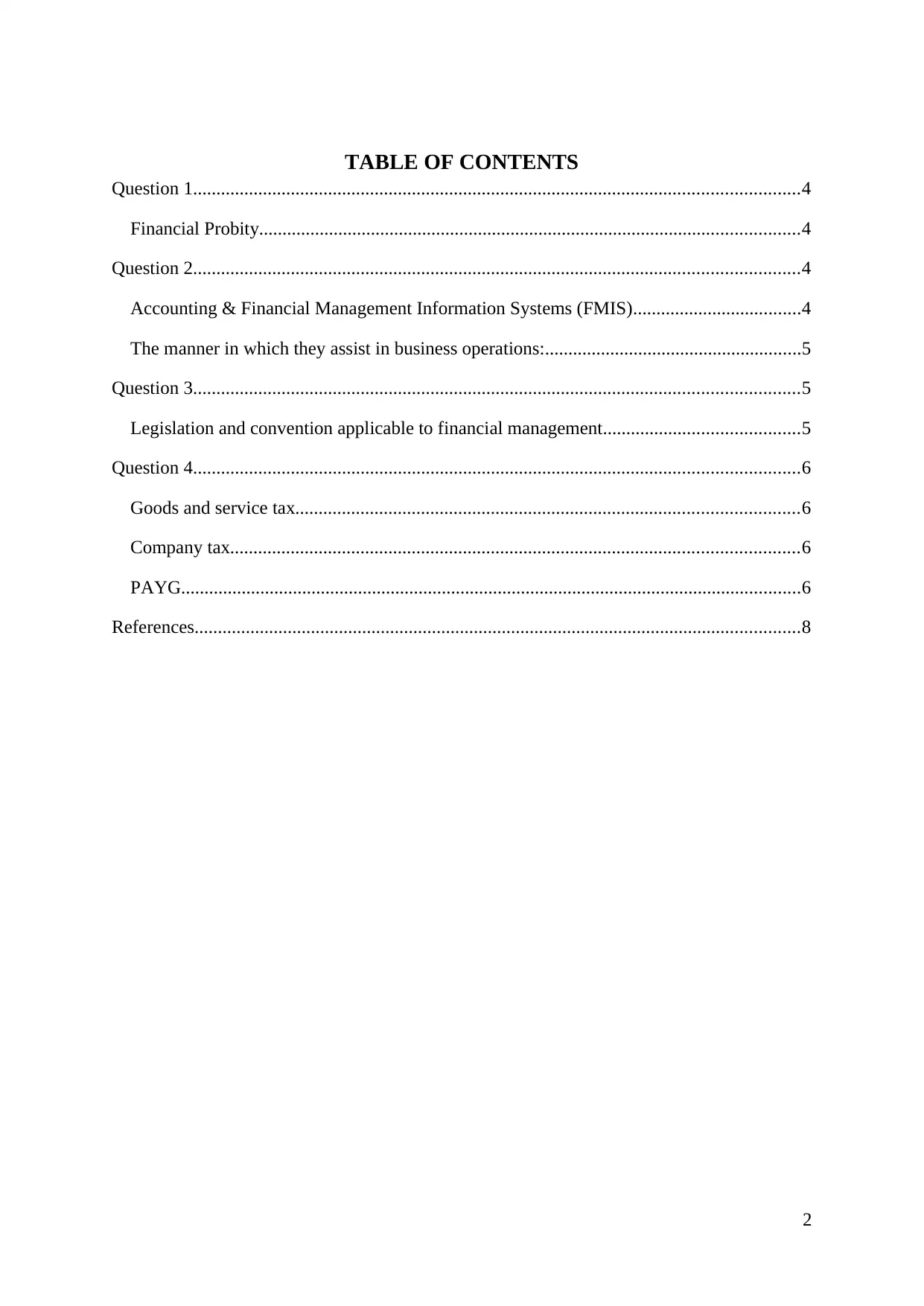
TABLE OF CONTENTS
Question 1..................................................................................................................................4
Financial Probity....................................................................................................................4
Question 2..................................................................................................................................4
Accounting & Financial Management Information Systems (FMIS)....................................4
The manner in which they assist in business operations:.......................................................5
Question 3..................................................................................................................................5
Legislation and convention applicable to financial management..........................................5
Question 4..................................................................................................................................6
Goods and service tax............................................................................................................6
Company tax..........................................................................................................................6
PAYG.....................................................................................................................................6
References..................................................................................................................................8
2
Question 1..................................................................................................................................4
Financial Probity....................................................................................................................4
Question 2..................................................................................................................................4
Accounting & Financial Management Information Systems (FMIS)....................................4
The manner in which they assist in business operations:.......................................................5
Question 3..................................................................................................................................5
Legislation and convention applicable to financial management..........................................5
Question 4..................................................................................................................................6
Goods and service tax............................................................................................................6
Company tax..........................................................................................................................6
PAYG.....................................................................................................................................6
References..................................................................................................................................8
2
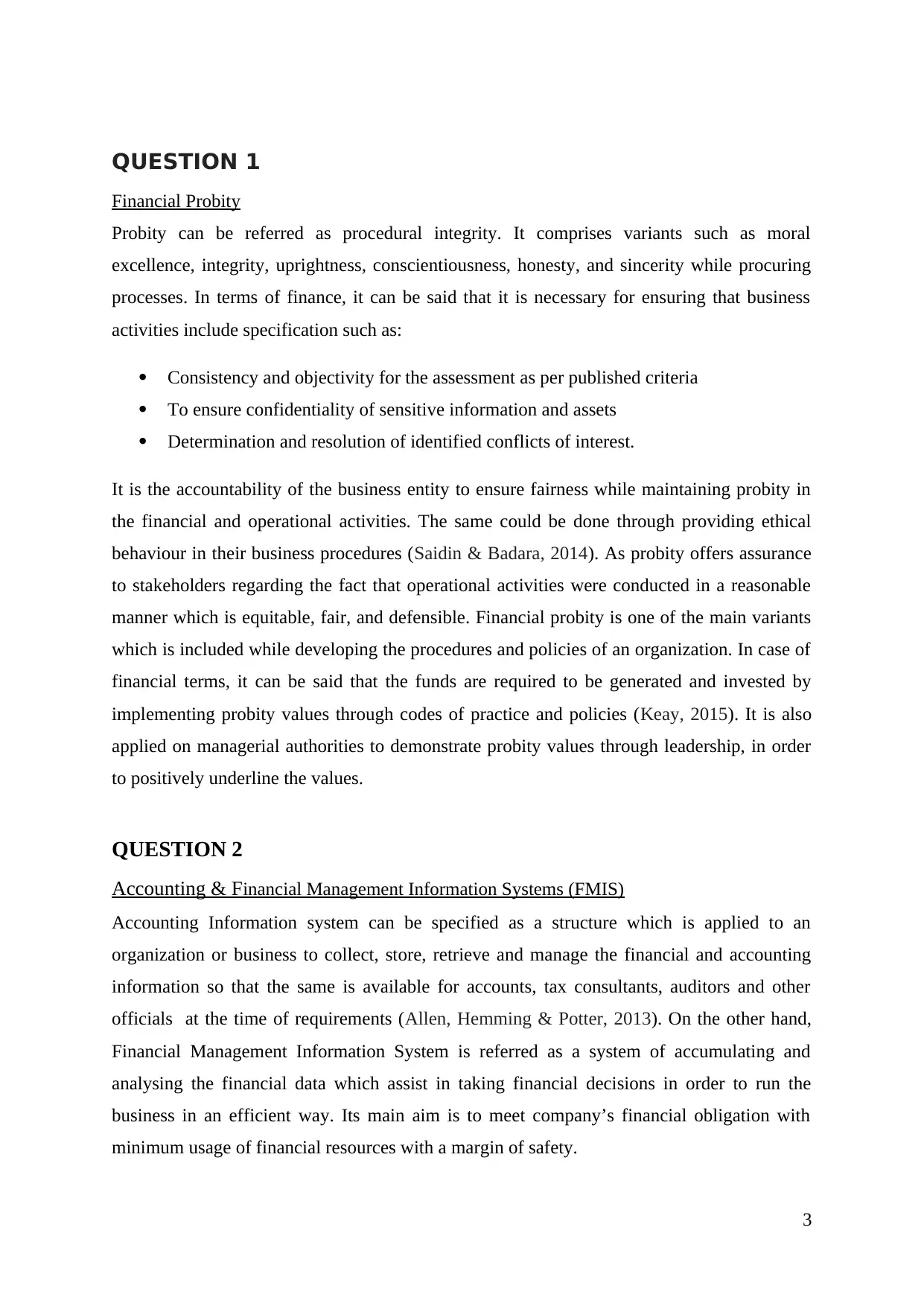
QUESTION 1
Financial Probity
Probity can be referred as procedural integrity. It comprises variants such as moral
excellence, integrity, uprightness, conscientiousness, honesty, and sincerity while procuring
processes. In terms of finance, it can be said that it is necessary for ensuring that business
activities include specification such as:
Consistency and objectivity for the assessment as per published criteria
To ensure confidentiality of sensitive information and assets
Determination and resolution of identified conflicts of interest.
It is the accountability of the business entity to ensure fairness while maintaining probity in
the financial and operational activities. The same could be done through providing ethical
behaviour in their business procedures (Saidin & Badara, 2014). As probity offers assurance
to stakeholders regarding the fact that operational activities were conducted in a reasonable
manner which is equitable, fair, and defensible. Financial probity is one of the main variants
which is included while developing the procedures and policies of an organization. In case of
financial terms, it can be said that the funds are required to be generated and invested by
implementing probity values through codes of practice and policies (Keay, 2015). It is also
applied on managerial authorities to demonstrate probity values through leadership, in order
to positively underline the values.
QUESTION 2
Accounting & Financial Management Information Systems (FMIS)
Accounting Information system can be specified as a structure which is applied to an
organization or business to collect, store, retrieve and manage the financial and accounting
information so that the same is available for accounts, tax consultants, auditors and other
officials at the time of requirements (Allen, Hemming & Potter, 2013). On the other hand,
Financial Management Information System is referred as a system of accumulating and
analysing the financial data which assist in taking financial decisions in order to run the
business in an efficient way. Its main aim is to meet company’s financial obligation with
minimum usage of financial resources with a margin of safety.
3
Financial Probity
Probity can be referred as procedural integrity. It comprises variants such as moral
excellence, integrity, uprightness, conscientiousness, honesty, and sincerity while procuring
processes. In terms of finance, it can be said that it is necessary for ensuring that business
activities include specification such as:
Consistency and objectivity for the assessment as per published criteria
To ensure confidentiality of sensitive information and assets
Determination and resolution of identified conflicts of interest.
It is the accountability of the business entity to ensure fairness while maintaining probity in
the financial and operational activities. The same could be done through providing ethical
behaviour in their business procedures (Saidin & Badara, 2014). As probity offers assurance
to stakeholders regarding the fact that operational activities were conducted in a reasonable
manner which is equitable, fair, and defensible. Financial probity is one of the main variants
which is included while developing the procedures and policies of an organization. In case of
financial terms, it can be said that the funds are required to be generated and invested by
implementing probity values through codes of practice and policies (Keay, 2015). It is also
applied on managerial authorities to demonstrate probity values through leadership, in order
to positively underline the values.
QUESTION 2
Accounting & Financial Management Information Systems (FMIS)
Accounting Information system can be specified as a structure which is applied to an
organization or business to collect, store, retrieve and manage the financial and accounting
information so that the same is available for accounts, tax consultants, auditors and other
officials at the time of requirements (Allen, Hemming & Potter, 2013). On the other hand,
Financial Management Information System is referred as a system of accumulating and
analysing the financial data which assist in taking financial decisions in order to run the
business in an efficient way. Its main aim is to meet company’s financial obligation with
minimum usage of financial resources with a margin of safety.
3
⊘ This is a preview!⊘
Do you want full access?
Subscribe today to unlock all pages.

Trusted by 1+ million students worldwide
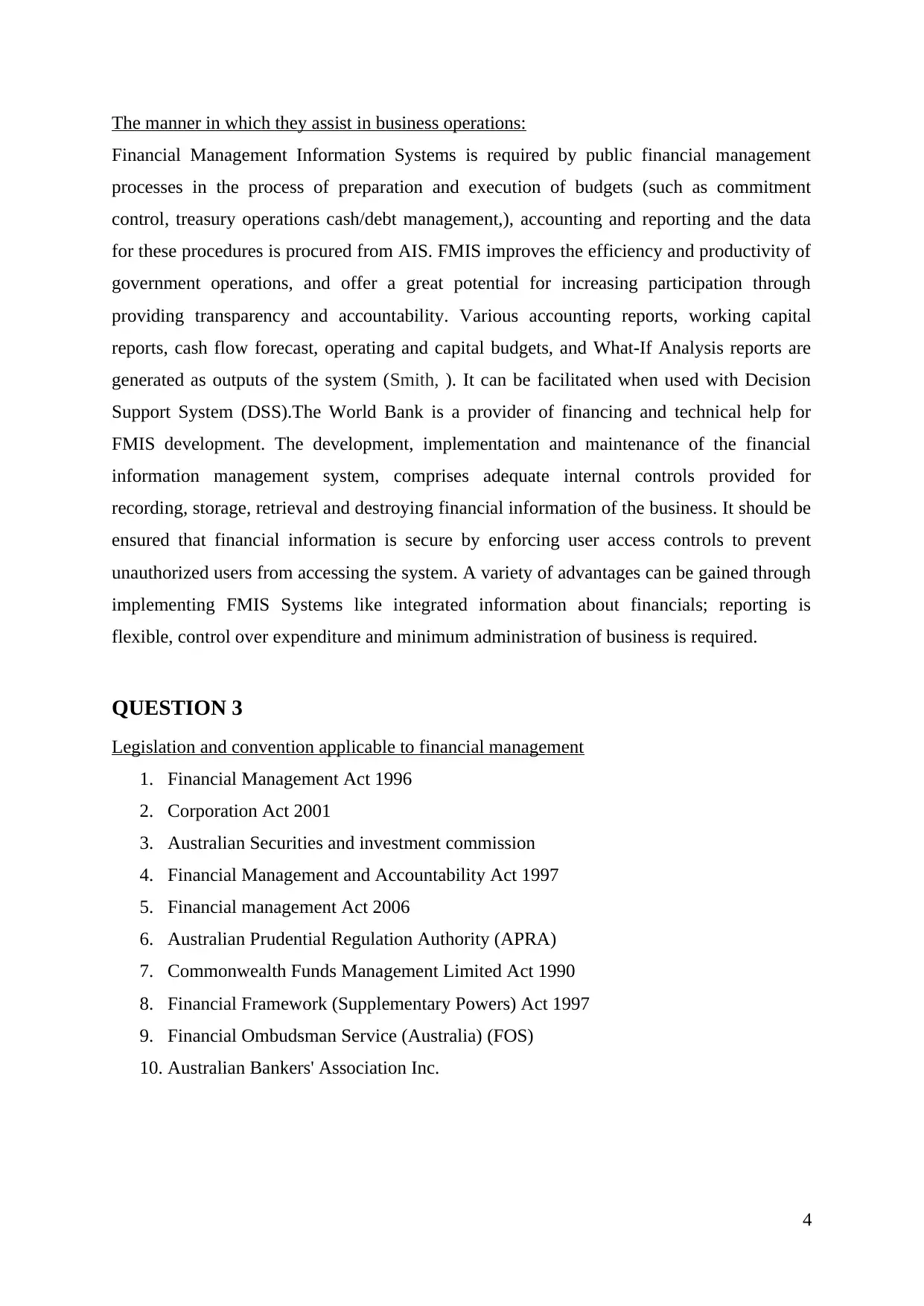
The manner in which they assist in business operations:
Financial Management Information Systems is required by public financial management
processes in the process of preparation and execution of budgets (such as commitment
control, treasury operations cash/debt management,), accounting and reporting and the data
for these procedures is procured from AIS. FMIS improves the efficiency and productivity of
government operations, and offer a great potential for increasing participation through
providing transparency and accountability. Various accounting reports, working capital
reports, cash flow forecast, operating and capital budgets, and What-If Analysis reports are
generated as outputs of the system (Smith, ). It can be facilitated when used with Decision
Support System (DSS).The World Bank is a provider of financing and technical help for
FMIS development. The development, implementation and maintenance of the financial
information management system, comprises adequate internal controls provided for
recording, storage, retrieval and destroying financial information of the business. It should be
ensured that financial information is secure by enforcing user access controls to prevent
unauthorized users from accessing the system. A variety of advantages can be gained through
implementing FMIS Systems like integrated information about financials; reporting is
flexible, control over expenditure and minimum administration of business is required.
QUESTION 3
Legislation and convention applicable to financial management
1. Financial Management Act 1996
2. Corporation Act 2001
3. Australian Securities and investment commission
4. Financial Management and Accountability Act 1997
5. Financial management Act 2006
6. Australian Prudential Regulation Authority (APRA)
7. Commonwealth Funds Management Limited Act 1990
8. Financial Framework (Supplementary Powers) Act 1997
9. Financial Ombudsman Service (Australia) (FOS)
10. Australian Bankers' Association Inc.
4
Financial Management Information Systems is required by public financial management
processes in the process of preparation and execution of budgets (such as commitment
control, treasury operations cash/debt management,), accounting and reporting and the data
for these procedures is procured from AIS. FMIS improves the efficiency and productivity of
government operations, and offer a great potential for increasing participation through
providing transparency and accountability. Various accounting reports, working capital
reports, cash flow forecast, operating and capital budgets, and What-If Analysis reports are
generated as outputs of the system (Smith, ). It can be facilitated when used with Decision
Support System (DSS).The World Bank is a provider of financing and technical help for
FMIS development. The development, implementation and maintenance of the financial
information management system, comprises adequate internal controls provided for
recording, storage, retrieval and destroying financial information of the business. It should be
ensured that financial information is secure by enforcing user access controls to prevent
unauthorized users from accessing the system. A variety of advantages can be gained through
implementing FMIS Systems like integrated information about financials; reporting is
flexible, control over expenditure and minimum administration of business is required.
QUESTION 3
Legislation and convention applicable to financial management
1. Financial Management Act 1996
2. Corporation Act 2001
3. Australian Securities and investment commission
4. Financial Management and Accountability Act 1997
5. Financial management Act 2006
6. Australian Prudential Regulation Authority (APRA)
7. Commonwealth Funds Management Limited Act 1990
8. Financial Framework (Supplementary Powers) Act 1997
9. Financial Ombudsman Service (Australia) (FOS)
10. Australian Bankers' Association Inc.
4
Paraphrase This Document
Need a fresh take? Get an instant paraphrase of this document with our AI Paraphraser
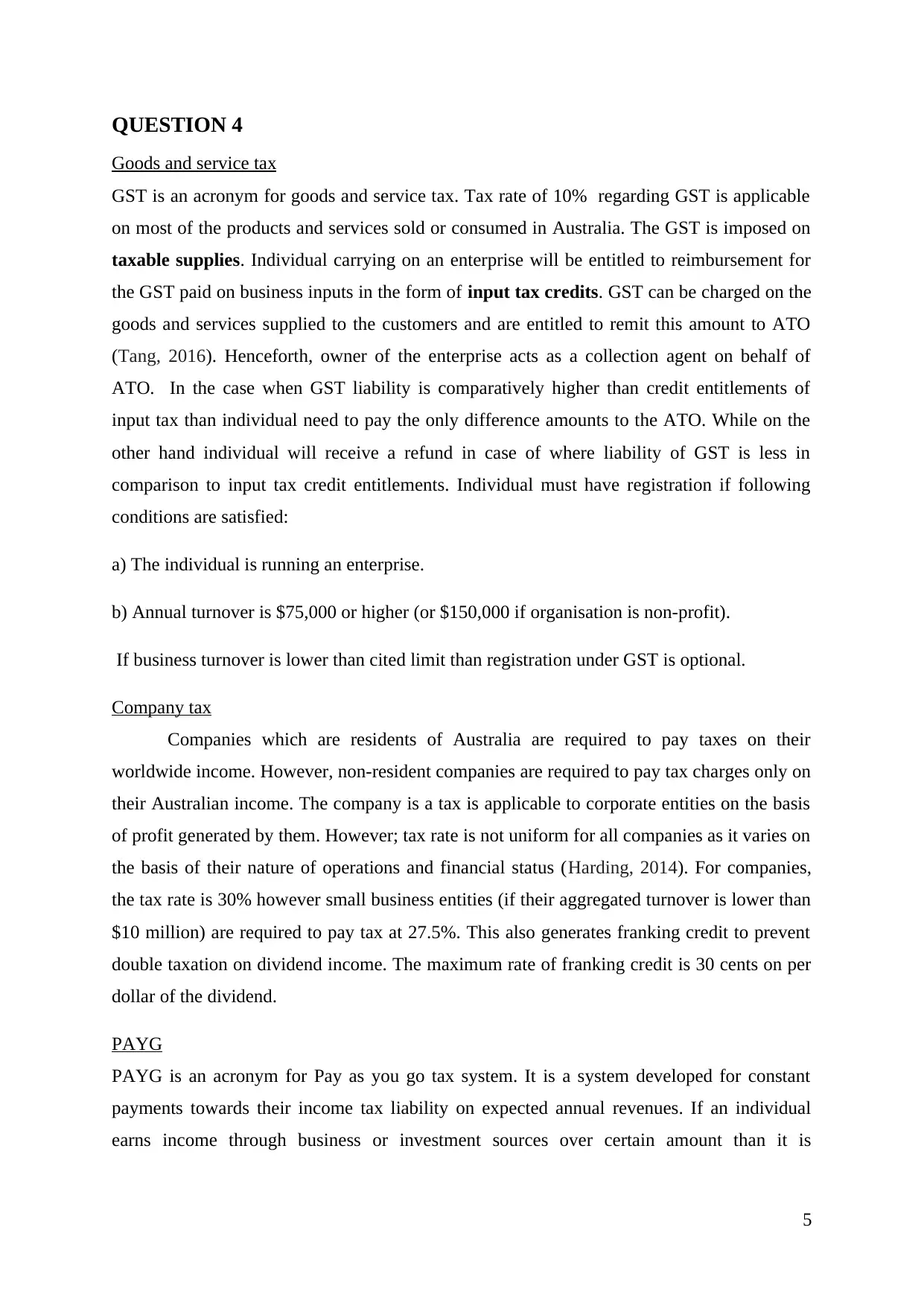
QUESTION 4
Goods and service tax
GST is an acronym for goods and service tax. Tax rate of 10% regarding GST is applicable
on most of the products and services sold or consumed in Australia. The GST is imposed on
taxable supplies. Individual carrying on an enterprise will be entitled to reimbursement for
the GST paid on business inputs in the form of input tax credits. GST can be charged on the
goods and services supplied to the customers and are entitled to remit this amount to ATO
(Tang, 2016). Henceforth, owner of the enterprise acts as a collection agent on behalf of
ATO. In the case when GST liability is comparatively higher than credit entitlements of
input tax than individual need to pay the only difference amounts to the ATO. While on the
other hand individual will receive a refund in case of where liability of GST is less in
comparison to input tax credit entitlements. Individual must have registration if following
conditions are satisfied:
a) The individual is running an enterprise.
b) Annual turnover is $75,000 or higher (or $150,000 if organisation is non-profit).
If business turnover is lower than cited limit than registration under GST is optional.
Company tax
Companies which are residents of Australia are required to pay taxes on their
worldwide income. However, non-resident companies are required to pay tax charges only on
their Australian income. The company is a tax is applicable to corporate entities on the basis
of profit generated by them. However; tax rate is not uniform for all companies as it varies on
the basis of their nature of operations and financial status (Harding, 2014). For companies,
the tax rate is 30% however small business entities (if their aggregated turnover is lower than
$10 million) are required to pay tax at 27.5%. This also generates franking credit to prevent
double taxation on dividend income. The maximum rate of franking credit is 30 cents on per
dollar of the dividend.
PAYG
PAYG is an acronym for Pay as you go tax system. It is a system developed for constant
payments towards their income tax liability on expected annual revenues. If an individual
earns income through business or investment sources over certain amount than it is
5
Goods and service tax
GST is an acronym for goods and service tax. Tax rate of 10% regarding GST is applicable
on most of the products and services sold or consumed in Australia. The GST is imposed on
taxable supplies. Individual carrying on an enterprise will be entitled to reimbursement for
the GST paid on business inputs in the form of input tax credits. GST can be charged on the
goods and services supplied to the customers and are entitled to remit this amount to ATO
(Tang, 2016). Henceforth, owner of the enterprise acts as a collection agent on behalf of
ATO. In the case when GST liability is comparatively higher than credit entitlements of
input tax than individual need to pay the only difference amounts to the ATO. While on the
other hand individual will receive a refund in case of where liability of GST is less in
comparison to input tax credit entitlements. Individual must have registration if following
conditions are satisfied:
a) The individual is running an enterprise.
b) Annual turnover is $75,000 or higher (or $150,000 if organisation is non-profit).
If business turnover is lower than cited limit than registration under GST is optional.
Company tax
Companies which are residents of Australia are required to pay taxes on their
worldwide income. However, non-resident companies are required to pay tax charges only on
their Australian income. The company is a tax is applicable to corporate entities on the basis
of profit generated by them. However; tax rate is not uniform for all companies as it varies on
the basis of their nature of operations and financial status (Harding, 2014). For companies,
the tax rate is 30% however small business entities (if their aggregated turnover is lower than
$10 million) are required to pay tax at 27.5%. This also generates franking credit to prevent
double taxation on dividend income. The maximum rate of franking credit is 30 cents on per
dollar of the dividend.
PAYG
PAYG is an acronym for Pay as you go tax system. It is a system developed for constant
payments towards their income tax liability on expected annual revenues. If an individual
earns income through business or investment sources over certain amount than it is
5
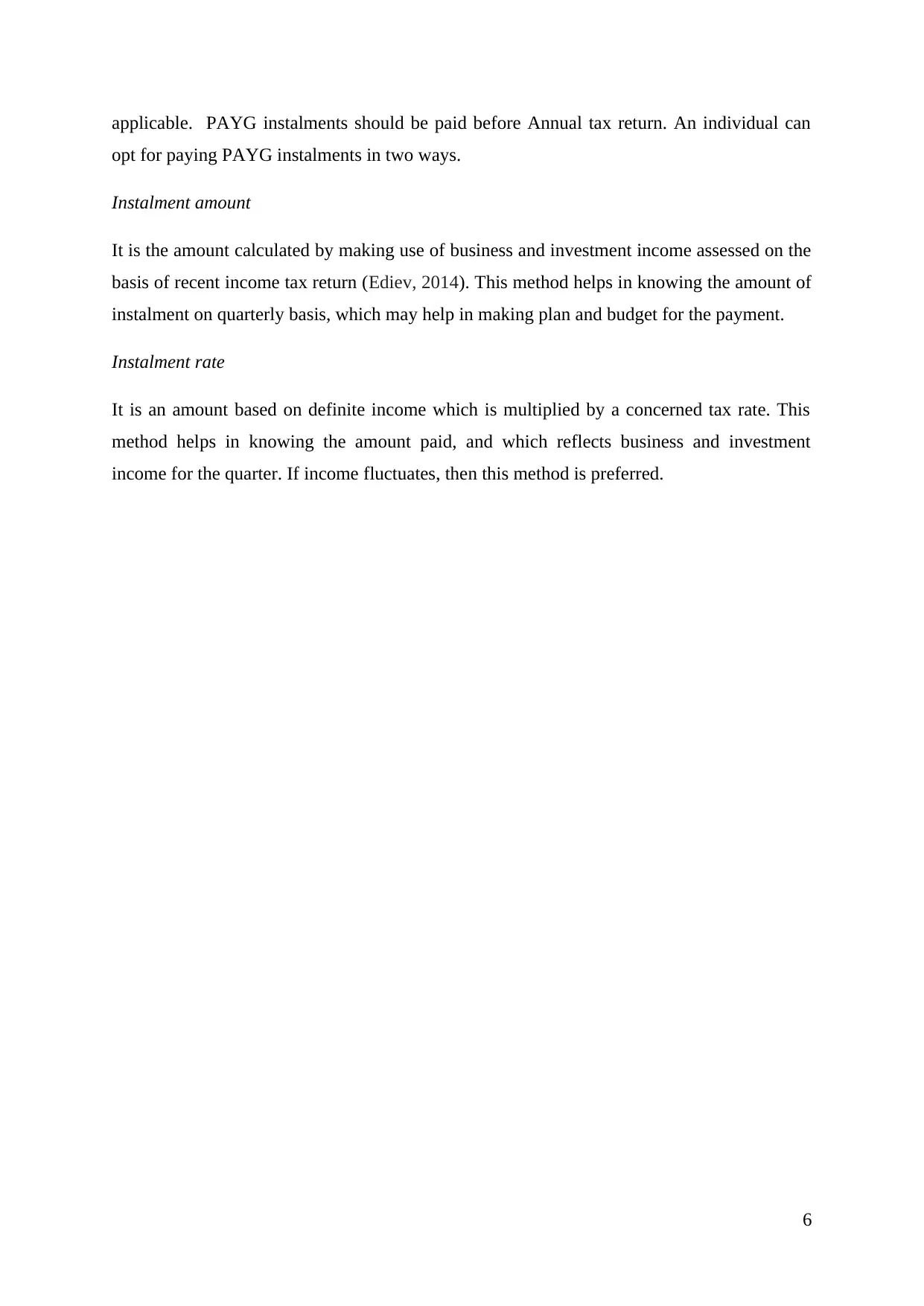
applicable. PAYG instalments should be paid before Annual tax return. An individual can
opt for paying PAYG instalments in two ways.
Instalment amount
It is the amount calculated by making use of business and investment income assessed on the
basis of recent income tax return (Ediev, 2014). This method helps in knowing the amount of
instalment on quarterly basis, which may help in making plan and budget for the payment.
Instalment rate
It is an amount based on definite income which is multiplied by a concerned tax rate. This
method helps in knowing the amount paid, and which reflects business and investment
income for the quarter. If income fluctuates, then this method is preferred.
6
opt for paying PAYG instalments in two ways.
Instalment amount
It is the amount calculated by making use of business and investment income assessed on the
basis of recent income tax return (Ediev, 2014). This method helps in knowing the amount of
instalment on quarterly basis, which may help in making plan and budget for the payment.
Instalment rate
It is an amount based on definite income which is multiplied by a concerned tax rate. This
method helps in knowing the amount paid, and which reflects business and investment
income for the quarter. If income fluctuates, then this method is preferred.
6
⊘ This is a preview!⊘
Do you want full access?
Subscribe today to unlock all pages.

Trusted by 1+ million students worldwide
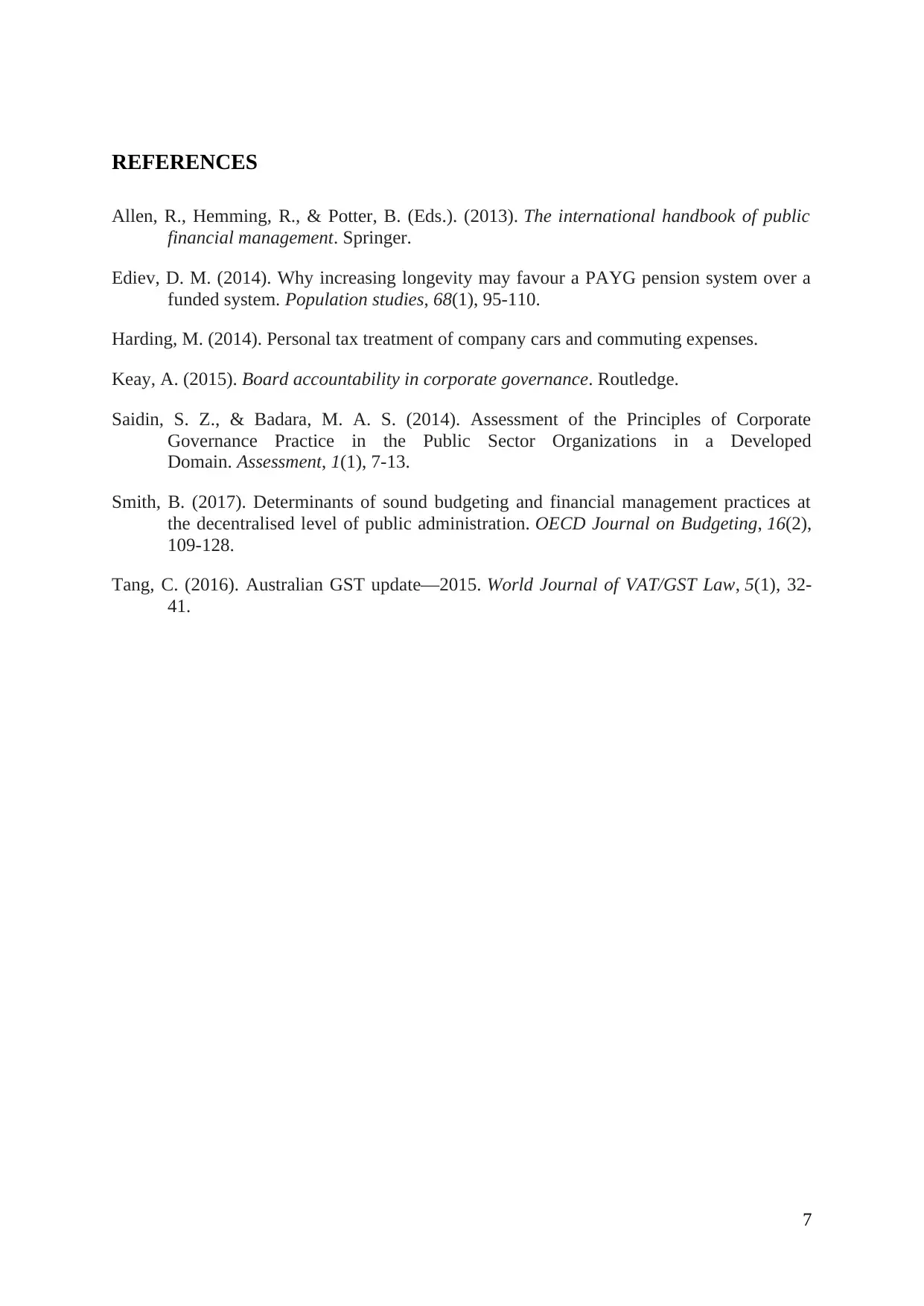
REFERENCES
Allen, R., Hemming, R., & Potter, B. (Eds.). (2013). The international handbook of public
financial management. Springer.
Ediev, D. M. (2014). Why increasing longevity may favour a PAYG pension system over a
funded system. Population studies, 68(1), 95-110.
Harding, M. (2014). Personal tax treatment of company cars and commuting expenses.
Keay, A. (2015). Board accountability in corporate governance. Routledge.
Saidin, S. Z., & Badara, M. A. S. (2014). Assessment of the Principles of Corporate
Governance Practice in the Public Sector Organizations in a Developed
Domain. Assessment, 1(1), 7-13.
Smith, B. (2017). Determinants of sound budgeting and financial management practices at
the decentralised level of public administration. OECD Journal on Budgeting, 16(2),
109-128.
Tang, C. (2016). Australian GST update—2015. World Journal of VAT/GST Law, 5(1), 32-
41.
7
Allen, R., Hemming, R., & Potter, B. (Eds.). (2013). The international handbook of public
financial management. Springer.
Ediev, D. M. (2014). Why increasing longevity may favour a PAYG pension system over a
funded system. Population studies, 68(1), 95-110.
Harding, M. (2014). Personal tax treatment of company cars and commuting expenses.
Keay, A. (2015). Board accountability in corporate governance. Routledge.
Saidin, S. Z., & Badara, M. A. S. (2014). Assessment of the Principles of Corporate
Governance Practice in the Public Sector Organizations in a Developed
Domain. Assessment, 1(1), 7-13.
Smith, B. (2017). Determinants of sound budgeting and financial management practices at
the decentralised level of public administration. OECD Journal on Budgeting, 16(2),
109-128.
Tang, C. (2016). Australian GST update—2015. World Journal of VAT/GST Law, 5(1), 32-
41.
7
1 out of 7
Related Documents
Your All-in-One AI-Powered Toolkit for Academic Success.
+13062052269
info@desklib.com
Available 24*7 on WhatsApp / Email
![[object Object]](/_next/static/media/star-bottom.7253800d.svg)
Unlock your academic potential
Copyright © 2020–2025 A2Z Services. All Rights Reserved. Developed and managed by ZUCOL.
![BSBFIM601 Manage Finances: Assessment Report, [Semester], [College]](/_next/image/?url=https%3A%2F%2Fdesklib.com%2Fmedia%2Fimages%2Fxm%2F162b9d69229e4e1db10d1eff3736f19c.jpg&w=256&q=75)




